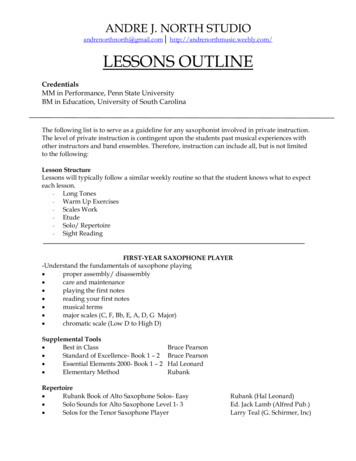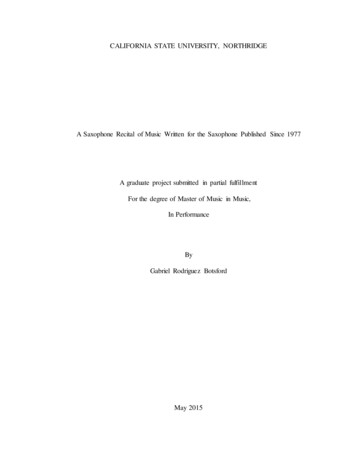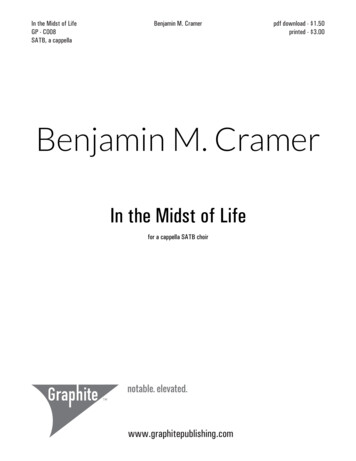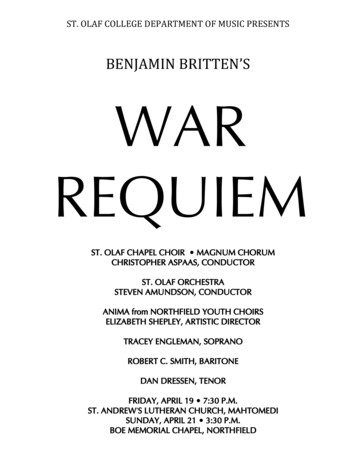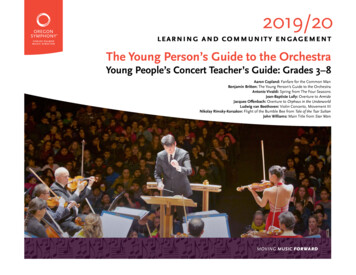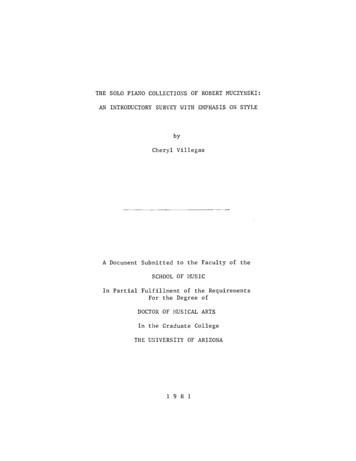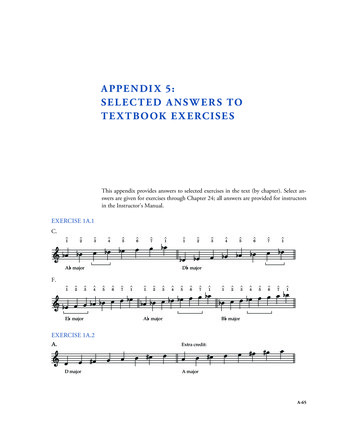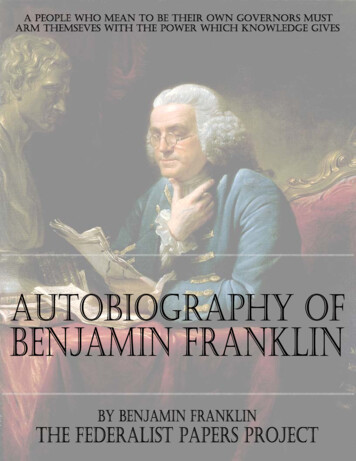
Transcription
BENJAMIN BRITTEN‟S SONATA IN C FOR CELLO AND PIANO, OP. 65:A PRACTICAL GUIDE FOR PERFORMANCEJeong-A Lee, B.M., M.M.Dissertation Prepared for the Degree ofDOCTOR OF MUSICAL ARTSUNIVERSITY OF NORTH TEXASMay 2009APPROVED:Eugene Osadchy, Major ProfessorSusan Dubois, Co-Major ProfessorClay Couturiaux, Related Field ProfessorPhilip Lewis, Committee MemberGraham H. Phipps, Director of GraduateStudies in the College of MusicJames C. Scott, Dean of the College ofMusicMichael Monticino, Interim Dean of theRobert B. Toulouse School ofGraduate Studies
Lee, Jeong-A. Benjamin Britten’s Sonata in C for Cello and Piano, Op. 65: A PracticalGuide for Performance. Doctor of Musical Arts (Performance), May 2009, 49 pp., 24 musicalexamples, bibliography, 61 titles.Benjamin Britten is a renowned and prolific English composer, well known for his operasand vocal works. He did, however, also compose five works especially for the cello as a soloinstrument of which the Sonata in C for Cello and Piano Op. 65 was the first. He was inspiredby one of his musical contemporaries, the remarkable Soviet cellist, Mstislav Rostropovich.Rostropovich was famous for his amazing artistry which propelled him to become one of themost prominent cellists in the world during his time. Thus Britten, who had previously onlycomposed for cello as part of ensembles, created this sonata specifically thinking ofRostropovich and his outstanding skill as a cellist. The premiere of the sonata took place in July1961 at the Aldeburgh Festival and it was a great success.However, despite Britten’s reputation as an outstanding composer and the significance ofthe sonata, this sonata has been performed infrequently. Britten utilized many challengingtechniques and adapted them innovatively in the composition, and perhaps performers may bereluctant to choose this work due to the complexity and challenge inherent in the compositionitself. The purpose of this dissertation is to provide a practical guide for students and those whowish to learn and perform Britten’s Sonata in C for Cello and Piano, Op. 65 by increasingunderstanding of the work, and by offering practical assistance.
Copyright 2009ByJeong-A Leeii
TABLE OF CONTENTSLIST OF MUSICAL EXAMPLES - - - - - - - - - - - - - - - - - - - - - - - - - - - - - - - - - - - - - - - - - ivChapter1. INTRODUCTION - - - - - - - - - - - - - - - - - - - - - - - - - - - - - - - - - - - - - - - - - - - - - - - 12. THE LIFE OF BENJAMIN BRITTEN - - - - - - - - - - - - - - - - - - - - - - - - - - - - - - - - - 43. BACKGROUND OF BENJAMIN BRITTEN‟S SONATA IN C FOR CELLO ANDPIANO, OP.65 - - - - - - - - - - - - - - - - - - - - - - - - - - - - - - - - - - - - - - - - - - - - - - - - - 154. BENJAMIN BRITTEN‟S SONATA IN C FOR CELLO AND PIANO, OP.65: APRACTICAL GUIDE FOR PERFORMANCE - - - - - - - - - - - - - - - - - - - - - - - - - - - 18I. First Movement: Dialogo - - - - - - - - - - - - - - - - - - - - - - - - - - - - - - - - - - - - - II. Second Movement: Scherzo-Pizzicato - - - - - - - - - - - - - - - - - - - - - - - - - - - - III. Third Movement: Elegia - - - - - - - - - - - - - - - - - - - - - - - - - - - - - - - - - - - - - IV. Fourth Movement: Marcia - - - - - - - - - - - - - - - - - - - - - - - - - - - - - - - - - - - - V. Fifth Movement: Moto Perpetuo - - - - - - - - - - - - - - - - - - - - - - - - - - - - - - - -18242934395. CONCLUSION - - - - - - - - - - - - - - - - - - - - - - - - - - - - - - - - - - - - - - - - - - - - - - - - 45BIBLIOGRAPHY - - - - - - - - - - - - - - - - - - - - - - - - - - - - - - - - - - - - - - - - - - - - - - - - - - - 46iii
LIST OF MUSICAL EXAMPLESPageExample 1. Sonata for Cello and Piano, Op.65, I. Dialogo, Mm. 1-4 - - - - - - - - - - - - - 19Example 2. Sonata for Cello and Piano, Op. 65, I. Dialogo, Mm. 26-32 - - - - - - - - - - - 20Example 3. Sonata for Cello and Piano, op. 65, I. Dialogo, Mm. 142-147 - - - - - - - - - 21Example 4. Sonata for Cello and Piano, Op.65, I. Dialogo, Mm. 42-46 - - - - - - - - - - - 22Example 5. Sonata for Cello and Piano, Op.65, I. Dialogo, Mm. 207-212 - - - - - - - - - 23Example 6. Sonata for Cello and Piano, Op.65, I. Dialogo, Mm. 261-267 - - - - - - - - - - 24Example 7. Sonata for Cello and Piano, Op.65, II. Scherzo-Pizzicato, Mm. 1-2 - - - - - - 25Example 8. Sonata for Cello and Piano, Op.65, II. Scherzo-Pizzicato, Mm.5-7 - - - - - - 26Example 9. Sonata for Cello and Piano, Op.65, II. Scherzo-Pizzicato, Mm.12-18 - - - - 26Example 10. Sonata for Cello and Piano, Op.65, II. Scherzo-Pizzicato, Mm.40-51 - - - - 28Example 11. Sonata for Cello and Piano, Op.65, III. Elegia, Mm. 4-5 - - - - - - - - - - - - 29Example 12. Sonata for Cello and Piano, Op.65, III. Elegia, Mm. 44-48 - - - - - - - - - - 31Example 13. Sonata for Cello and Piano, Op.65, III. Elegia, Mm. 34-35- - - - - - - - - - - 32Example 14. Sonata for Cello and Piano, Op.65, III. Elegia, Mm. 36-37 - - - - - - - - - - 32Example 15. Sonata for Cello and Piano, Op.65, III. Elegia, Mm. 41-43 - - - - - - - - - - 33Example 16. The study of chords from the E-flat Prelude by Bach - - - - - - - - - - - - - - 34Example 17. Sonata for Cello and Piano, Op.65, IV. Marcia, Mm. 28-31 - - - - - - - - - - 35Example 18. Sonata for Cello and Piano, Op.65, IV. Marcia, Mm. 21-24 - - - - - - - - - - 36Example 19. Sonata for Cello and Piano, Op.65, IV. Marcia, Mm. 43-46 - - - - - - - - - 37Example 20. Sonata for Cello and Piano, Op.65, IV. Marcia, Mm. 65-69 - - - - - - - - - 37Example 21. The Exercises for artificial harmonics - - - - - - - - - - - - - - - - - - - - - - - - 39Example 22. Sonata for Cello and Piano, Op.65, V. Moto Perpetuo, Mm. 1-4 - - - - - - - 40Example 23. Sonata for Cello and Piano, Op.65, V. Moto Perpetuo, Mm. 61-64 - - - - - 42Example 24. Sonata for Cello and Piano, Op.65, V. Moto Perpetuo, Mm. 90-94 - - - - - 43iv
CHAPTER 1INTRODUCTIONBenjamin Britten is a renowned and prolific English composer, well known for his operasand vocal works. He did, however, also compose five works especially for the cello as a soloinstrument, of which the Sonata in C for Cello and Piano Op. 65 was the first. He was inspiredby one of his musical contemporaries, the remarkable Soviet cellist, Mstislav Rostropovich. 1Rostropovich was famous for his amazing artistry which propelled him to become one of themost prominent cellists in the world during his time. Thus Britten, who had previously onlycomposed for cello as part of ensembles, created this sonata specifically thinking ofRostropovich and his outstanding skill as a cellist. The premiere of the Sonata took place in July1961 at the Aldeburgh Festival and it was a great success.However, despite Britten‟s reputation as an outstanding composer and the significance of thesonata, this sonata has been performed infrequently. Britten utilized many challengingtechniques and adapted them innovatively in the composition, and perhaps performers may bereluctant to choose this work due to the complexity and challenge inherent in the compositionitself.Although there is a fair amount of information available related to the Sonata in C for Celloand Piano Op.65, most is not helpful to the musician from a practical performance perspective.There is a plethora of information relating to Britten‟s operas and vocal works. However, thereis a dearth of information addressing his chamber works. As well, there are numerousbiographical books and articles giving information about Britten himself, but that scarcely1Peter Evans, The Music of Benjamin Britten (Minneapolis: University of Minnesota Press, 1979), 307.1
mention his cello works. There are, however, a few dissertations that have been written relatedto Britten‟s cello works, and this particular Sonata, including the following: Benjamin Britten and Chamber Music: The Sonata in C for Cello and Piano, Op 65, byYoko Hirota. This work provides an excellent overview of historical background andanalysis of the sonata. It is interesting in that it was written from a pianist‟s point ofview. It is definitely a useful reference of the cello sonata. Unfortunately, there is noapplication to the performance aspect. Innovative use of technique in Benjamin Britten’s Cello Works: The inspiration ofMstislav Rostropovich by Elizabeth Shin-I Su, is a dissertation which does focus on theperformance practice aspect. However, her research is directed towards BenjaminBritten‟s entire cello works and not specifically to this sonata. As a result, the portion ofthe discussion of this sonata is limited and the details sketchy. An Analytical Study of the Sonata in C for Cello and Piano by Benjamin Britten, writtenby Charles Baker. This work provides an excellent, in-depth analysis of the fivemovements of the sonata, as well as general application to performance. However,although it is an important reference for the cello sonata, its lengthy detailed theoreticalanalysis can be very overwhelming. As a result, it loses some of its usefulness forpractical application.What is missing is a practical guide for the musician to not only understand the work, but alsoprovide practical assistance in learning techniques to achieve the desired sounds.The purpose of this dissertation is to provide a practical guide for students and those whowish to learn and perform Britten‟s Sonata in C for Cello and Piano, Op. 65 by increasingunderstanding of the work, and by offering practical assistance.2
In the second chapter, a brief biographical sketch of Benjamin Britten, highlightingrelevant and significant information is presented. This section introduces the “person” of thecomposer of this sonata. Then some background of the sonata is presented in chapter three, witha look at the interesting relationship between the composer and the performer, MstislavRostropovich, which greatly shaped the resultant music. In the fourth chapter, the focus is an indepth, identification of the following: The overall characteristics of movements. The musical indication or vocabulary isdefined so as to help understand the mood which the composer set for each movement. Techniques that are used in each movement and their definition are identified. Further,how to approach practicing and mastering the techniques are given. Challenging techniques, with an explanation for why they are hard to achieve andpossible solutions are suggested. If applicable, specific exercises or studies that will improve technical ability aresuggested.3
CHAPTER 2THE LIFE OF BENJAMIN BRITTENIn order to gain a better understanding of a particular musical work, it is often helpful andinteresting to look at the composer of that work. This chapter presents the person, BenjaminBritten, by summarizing some highlights of his life.Benjamin Britten was born in the town of Lowestoft, in Suffolk, England on November22, 1913. An interesting coincidence is that his birthday fell on the Feast of St. Cecilia, thepatron saint of music.2 He was the youngest of four children born to Robert Britten (1878-1939),a dental surgeon, and Edith Rhoda (1874-1937), an amateur singer. Undoubtedly, his mother‟slove of music played an early role in nurturing the same in her son. By most accounts, hismother was a dominant influence on his early years, as she fully encouraged her children‟s loveof music.3 Britten commenced piano lessons at the age of seven, with Ethel Astle, and violalessons at age ten, with Audrey Alston. The latter quickly recognized that her pupil wasunusually gifted, and later introduced him to a highly professional musician, Frank Bridge.Bridge agreed to take the young Britten on as a student. Bridge was his principal teacher incomposition during the early years and became “the biggest single influence on Britten‟s musicallife.” 4 From Bridge he acquired “the integrity of his technique, his professionalism and hisawareness of the „new‟ music in Europe.” 5 Britten never forgot his teacher, and dedicated2Alan Kendall, Benjamin Britten (London: Macmillan London Ltd.,1973), 9.Donald Mitchell, “Britten, (Edward) Benjamin, Baron Britten (1913-1976),” in Oxford Dictionary of NationalBiography, http://www.oxforddnb.com/view/article/30853 (accessed 27 Feb 2008).4Donald Mitchell, Benjamin Britten: A Commentary on His Works from a group of specialists (NewYork:Philosophical library, 1952), 2.5Mitchell, “Britten, (Edward) Benjamin, Baron Britten (1913-1976)” (accessed 27 Feb 2008).34
several of his works to Bridge including Sinfonietta No.1, and Variation on a Theme of FrankBridge, Op.10.6As a child prodigy, Britten composed many musical compositions. When he was sixteen,he won a scholarship to the Royal College of Music. At Bridge‟s suggestion, Britten studiedcomposition with John Ireland. He also studied piano with Arthur Benjamin. At college, Brittenwas a highly ambitious student, writing a number of compositions and winning numerousawards. Of importance during those years, was that he first published his composition, theSinfonietta No. 1 for Chamber Orchestra. These college years also were a disappointment to theambitious young musical prodigy. Not many of his student colleagues were as advanced andambitious as he was, and he found that he was not challenged enough. In his words, “„When youare immensely full of energy and ideas, you don‟t want to waste your time being taken throughelementary exercises in dictation.‟” 7 He was also frustrated by the general amateurish attitudeof most of the students, as well as the fact that they displayed little interest in the style of musicthat he wished to write. Also disappointing for him was finding that the opportunities forperformance at the college were very restricted. For example, only one of his compositions, theSinfonietta No.1 for ten instruments, was ever performed,8 and, according to entries in his diary,he was displeased and frustrated with the quality of playing at rehearsals of his compositions.9Britten left the Royal College of Music in December 1933, and two years later, joined theGeneral Post Office Film Unit (GPO). As the unit‟s resident composer and music director, he6Kendall, Benjamin Britten, 11.Eric Walter White, Benjamin Britten: His Life and Operas, 2nd ed. (Berkeley: University of California Press,1983),23.8Kendall, Benjamin Britten, 12.9Donald Mitchell, ed. Letters from a Life: The Selected Letters and Diaries of Benjamin Britten 1913-1976. Vol. 1(Berkeley and Los Angeles: University of California, 1991), 276.75
produced incidental music for sixteen documentary films. This was a new and somewhatchallenging direction for him. He learned to write rapidly, devising sound effects to match thevisual aspects of films. This made a lasting impact on his own compositional style. Here Brittenmet and worked collaboratively with the English poet, W.H. Auden, who then worked for theGPO as script writer. Auden later became a very influential close friend to Britten. Accordingto Donald Mitchell, the first two films, Coal Face (1935) and Night Mail (1936) were consideredto be the most memorable of British documentary films, and the scores that Britten wrote forthese films made a highly original contribution to the history of music for the cinema.10Several factors played a role in Britten‟s next major decision. It was 1939, and thepolitical and economic climate, with increasing threat of war, was discouraging to the pacifistBritten. As well, the music of Britten‟s former teacher, Bridge, was achieving considerablesuccess and recognition in the United States. A further influence was that his friend Auden hadimmigrated to the United States. Thus Britten, together with his friend, tenor Peter Pears, movedto the United States, hoping for “better opportunities for artistic development.” 11In the summer of 1939, Britten‟s composition for orchestra, Variations on a Theme byFrank Bridge, written in 1937, was premiered by the New York Philharmonic Orchestra in NewYork. It was well received by the American audience. A number of other compositions werewritten by Britten during his stay in America, including:1011 Sinfonia da Requiem for orchestra, Op. 20 Seven Sonnets of Michelanngello for Tenor and Piano, Op.23 String Quartet No.1 in D, Op.25Mitchell, “Britten, (Edward) Benjamin, Baron Britten (1913-1976)” (accessed 27 Feb 2008).White, Benjamin Britten, 30.6
Scottish Ballad for Two Pianos and Orchestra, Op. 26 Hymn to St. Cecilia for Mixed Voices Unaccompanied, Op .27 A ceremony of Carols for Treble Voices and Harp, Op.28During his time in America, Britten gained in maturity as a composer and his careerseemed destined for success. Unfortunately, he suffered a period of mental illness, the details ofwhich are sketchy in the literature. Following this difficult time, and with some nostalgia for hisown country, he and his friend Pears returned to England in April 1942, where he “wanted tocontribute something new and powerful to British musical life.” 12Britten and Pears returned to England, which was then involved in World War II, andthey found their country heavily bombed. Old friends, including Frank Bridge, had died andseveral of Britten‟s school friends had been killed in the war.13 Britten and Pears were pacifists.Baker relates how Britten and Pears, rather than join the war effort, chose to face a tribunal aspacifists, arguing that in the cultural field, they were devoting their energies fully to the nationaladvantage. 14 They were granted exemption from military service.Britten channeled his great energy into prolific composing, as well as appearing at manyconcerts as pianist and accompanist for his friend, the tenor, Pears. In February 1945, Brittencompleted what was to become his first successful opera, Peter Grimes. On June 7, 1945, justone month after the war in Europe had ended, Peter Grimes was premiered at Sadler‟s WallsTheatre, with Pears singing the title role. This first performance was a great success, and soon12Philip Brett, et al. “Britten, Benjamin,” in Grove Music /article/grove/music/46435pg4 (accessed Feb 27, 2008).13Imogen Holst, Britten (London: Faber and Faber,1966), 37.14Charles A. Baker, “An Analytical Study of the Sonata in C for Cello and Piano by Benjamin Britten,” (D.M.A.diss., Eastman School of Music of the University of Rochester, 1965), 3.7
Peter Grimes became the most important opera by an English composer since Purcell‟s Dido andAeneas, written two hundred and fifty years earlier.15 A number of famous other operas werewritten by Britten, including: The Rape of Lucretia, Op.37 (1946) Billy Budd, Op.50 (1951) Gloriana, Op.53 (1953) The Turn of the Screw, Op.54 (1954) A Midsummer Night’s Dream, Op.64 (1960) Owen Wingrave, Op.85 (1971) Death in Venice, Op.88 (1973)The same year as Peter Grimes’ premiere, 1945, Britten was commissioned to write themusic for what was to be an educational film about the instruments of the orchestra. He wrote aset of variations and fugue based on Purcell‟s theme. He called these The Young Person’s Guideto the Orchestra, Op. 34, which has influenced generations of the young people for whom it waswritten – both to edify and to entertain, as Britten‟s dedication characteristically puts it – as wellas winning a permanent place in the orchestra repertory worldwide. 16In 1947, Britten moved to a house on the sea front in Aldeburgh. As Pears and Brittenwere traveling with the English Opera Group that summer, Pears suggested the idea of having amusic festival at Aldeburgh. Thus the Aldeburgh Festival was founded, and on June 1948, thefirst Aldeburgh Festival of Music and the Arts took place. Needless to say, many of Britten‟s15Boosey & Hawkes, “Benjamin Britten – In focus,” http://www.boosey.com/composer/Benjamin Britten (accessedFeb 27,2008).16Mitchell, “Britten, (Edward) Benjamin, Baron Britten (1913-1976)” (accessed 27 Feb 2008).8
works were featured in the performances, and the festival provided an excellent venue forintroducing Britten‟s new works for their first performances. As well, music by other composerswas featured, often those works that had been neglected or overlooked. In addition, music byBridge and Purcell were often included, along with that of other favorite composers such asMahler, Schubert, Mozart and Tchaikovsky. The Aldeburgh Festival grew in popularity andrenown as an institution within the music world. The significance to Britten, that Aldeburgh had,and its importance in his life, is reflected in his acceptance speech on receiving the Aspen Awardin 1964:I belong at home – there – in Aldeburgh. I have tried to bring music to it in the shape ofour local festival, and all the music I write comes from it. I believe in roots, inassociations, in backgrounds, in personal relationships . . . . My music now has its rootsin where I live and work. . . . 17Initially, the festival focused on the residents of Aldeburgh, both for its performers aswell as for its audiences. However, as the festival quickly grew in popularity, outsiders becameaware of it, and both guests and musicians from distant places were attracted to the venue. Moreartists from abroad were invited to become part of the festival. It became a veritable feast of thebest compositions presented by the most capable performers of the time. It was in this processthat Britten came into contact with the musician who was to be of great inspiration to him and hismusic, specifically to the musical work featured in this dissertation. This visiting musician wasthe famous Russian cellist, Mstislav Rostropovich. Britten was awed by Rostropovich‟s celloplaying and was inspired to write a number of works for Rostropovich, including: Sonata in Cfor Cello and Piano Op. 65 (1961), the focus of this paper, Symphony in D for Cello andOrchestra Op. 68, and Three Suites for Cello, Op. 72 (1964), Op. 80 (1967), and Op. 87 (1971).17Kendall, Benjamin Britten, 45.9
The Sonata in C for Cello and Piano Op. 65 was the first cello work composed by Britten. It wassatisfying for both Britten and Rostropovich that this piece was premiered, with success, byRostropovich with Britten at the Aldeburgh Festival. The relationship between these twomusicians, and the musical outcomes will be explored in greater depth in the next chapter.The year 1963, when Britten reached the age of fifty, was eventful. His friends wrote atribute titled Tribute to Benjamin Britten on his Fiftieth Birthday. As well, he was named “thegreatest composer alive” in a public tribute by Hans Keller. 18 Perhaps the most exciting eventwas when he and Pears were invited to Russia for festivals featuring British music. A number ofBritten‟s compositions, including his cello sonata, were performed in Moscow and Leningrad,where his music received a very warm reception from Russian audiences. 19 According toWhite, Britten expressed his gratitude to the Soviet public in an interview:I must own that until my arrival in the USSR, I was assailed with doubts whether theSoviet audiences would understand and accept our musical art which had beendeveloping along different national lines than the Russian. I am happy at having hadmy doubts dispelled at the very first concert. The Soviet public proved not onlyunusually musical – that I knew all along – but showed an enviable breadth of artisticperception. It is a wonderful public. 20The Aldeburgh Festival had continued to grow beyond its existing facility, and by themid – 1960‟s had found a new, much larger concert venue in the Maltings. On June 2, 1967, atthe beginning of the twentieth Aldeburgh Festival, it was formally opened by the queen. The18Brett, et al. “Britten, Benjamin,” in Grove Music Online, Oxford Music /article/grove/music/46435pg7 (accessed Feb 27, 2008).19White, Benjamin Britten, 95.20Ibid.10
new concert hall was generally acclaimed as one the finest in the country. 21 The new large hallwas able to accommodate major productions of opera as well as orchestral works.In 1970, Britten accepted a commission from the British Broadcasting Corporation tocompose his first opera to be written specifically for television, Owen Wingrave, Op. 85, and theopera was filmed at the Maltings, Snape, on November 1970. The world premiere broadcasttook place on May 16, 1971, and the first “live” performance was given at Covent Gardens in1973. 22 In June of 1973, his last opera, Death in Venice was premiered at the AldeburghFestival. Sadly, due to a deteriorating heart condition, he was unable to attend the premiere ofDeath in Venice. 23Britten‟s health continued to deteriorate, and the last three and a half years of his lifewere those of an invalid. He was easily exhausted and could only summon up enough energyand strength to devote limited time to composing. However, despite these obstacles, hesucceeded in composing several important new works, including, The Death of St. Narcissus, acanticle for tenor and harp, Phaedra, Op. 93, (1975), a dramatic cantata for mezzo-soprano andsmall orchestra, and String Quartet No. 3, Op. 94. 1975. Benjamin Britten died at his home, theRed House, Aldeburgh, on December 4, 1976. He was buried in the churchyard, within sightand sound of the sea he loved. 24Benjamin Britten is known as a prolific composer. He was a man, displaying sensitivityin his personality, his music and in his social life. He sought to express the depth of his emotionsin his music. He was also a great pianist, accompanist, and conductor, with great technical21Ibid., 102.Ibid., 106.23Evans, The Music of Benjamin Britten, 13.24White, Benjamin Britten, 107.2211
ability as well as a heightened understanding towards those who played with him. In hisdirecting, he was practical and efficient, as evidenced by his skill in directing the festival.Overall, he emerges as an incredible musician, a hard worker and perfectionist, who alwaysstrove to produce the best of what he was capable. This is the man who composed the musicalwork to be studied in subsequent chapters of this paper. Much has been written about BenjaminBritten. Included here are some snippets taken from Remembering Britten by Alan Blyth. Theyrepresent a range of persons who voiced opinions of the man based on their own experience withhim:Ben was extraordinarily sensitive as a pianist, both to what I wanted to do with a songand in what he wanted to achieve. He could make lighter sounds than anyone else. Ican recall . . . he knew precisely what color he wanted to project, and he managed todo it because of the speed with which his brain could communicate with the tip of hisfingers. That was an extraordinary phenomenon: mind and hand seemed in constanttouch. . . .25By Peter Pears (his close friend, singer)Ben was a very loving brother . . . . in spite of pressure of work, Ben always had timeto stop and listen to any problems we might have and help if he could. . . . He had somuch compassion for everyone, also humor and a great deal of fun. 26By Beth Welford (his sister)Britten has been for me the most purely musical person I have ever met and I haveever known. . . . Through his extraordinary musicality and fantastic technicalequipment, Britten was probably one of the finest accompanists on the piano ofanyone of his generation. 27By Michael Tippett (his contemporary composer)25Alan Blyth, Remembering Britten (London: Hutchison, 1981), 18.Ibid., 27.27Ibid., 70.2612
Britten knew precisely what he could do in terms of shaping his music and what hewas going to put in those shapes. . . . He had great inner confidence. . . .28By Lord Havewood (his friend)He never gave himself enough rest . . . . Pencil and paper were seldom out of hishands . . . .29By Miss Hudson (his housekeeper)Britten would go on rehearsing until he achieved the performance he had in hismind‟s ear; as conductor, player, composer and friend, Britten was a singularsounding-board with an ear for sensitive perfection.30By Mstislav Rostropovich (performer, cellist and friend)He was always aware of every detail of scoring in a work, and also of the extremeeconomy needed to make the festival a success.31By Imogen Holst (who worked closely for Britten)Britten had a low opinion of writers in newspapers, whom he considered to show apretty poor standard of competence . . .whereas he would have welcomed sympatheticand constructive criticism . . . . He felt that a work either communicated with anaudience or it did not.32By Donald Mitchell (editor)There certainly was an aura about him . . . . There was something special that madeyou give of your best . . . . From those who worked with him he demanded absoluteloyalty . . . . If anybody fell below his standards, they were asking for trouble.33By Dame Janet Baker (singer)28Ibid., 79.Ibid., 97.30Ibid., 151.31Ibid., 59.32Ibid., 133.33Ibid., 136, 139.2913
Britten‟s own programs were always at the heart of the planning, and were naturallythe most popular events, . . . . Where the expense of an event or the numbers neededfor a program were concerned, Britten was supreme. He was also tenacious inmaintaining standards and originality in programs. . . .34By Stephen Reiss (personal manager)He was the first British composer to capture and hold the attention of musicians andtheir audiences the world over, as well as at home; he was the first British composerto center his mature work prolifically on the musical theatre – grand opera, chamberopera, sacred music – drama.35By Peter Evans (author of The Music of Benjamin Britten)3435Ibid., 125.Evans, The Music of Benjamin Britten, 1.14
CHAPTER 3THE BACKGROUND OF THE SONATAThis section will briefly address the circumstances that led to the composing of theSonata in C for Cello and Piano Op. 65. As mentioned in the previous chapter, encountersbetween Britten and Rostropovich were the catalyst.The first encounter of these two musicians occurred in September, 1960, in the greenroom at the Royal Festival Hall in London. At the festival, Rostropovich played a cello concertoby the Russian compo
BENJAMIN BRITTEN‟S SONATA IN C FOR CELLO AND PIANO, OP. 65: A PRACTICAL GUIDE FOR PERFORMANCE Jeong-A Lee, B.M., M.M. Dissertation Prepared for the Degree of DOCTOR OF MUSICAL ARTS . of music.3 Britten commenced piano lessons at the age of seven, with Ethel Astle, and viola lessons at age ten, with Audrey Alston. The latter quickly .
